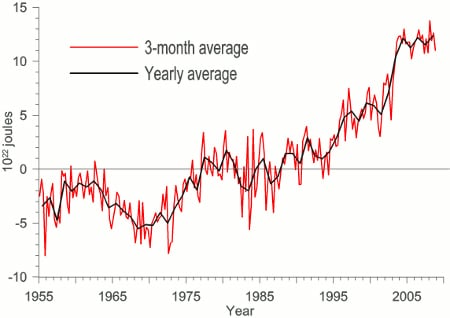Deniers Water Down Ocean Heating Trends
Have a look at the graph at left and ask yourself: does this indicate warming or cooling in the earth’s ocean?
Or check out this graph:
If you said that these images appear to indicate an alarming warming trend, give your head a shake, because the people posting and commenting on these graphs are arguing exactly the opposite.
The first graph, which came originally from an excellent peer-reviewed study in the Journal of Geophysical Researc Letters (Levitus et al: Global Ocean Heat Content), was posted by the climate quibbler Roger A. Pielke Sr. in a post that pronounced this all good news – that climate has, in fact, stopped changing. Pielke says:
“The new Levitus et al. 2009 paper, while not discussing this issue, further confirms that global warming, using upper ocean heat content as the metric, has stopped, at least for now.”
And thank goodness for that.
The second image, also using data from Levitus and adding the volcano data at the bottom, came from a post (Does Ocean Cooling Disprove Global Warming) by John Cook on Skeptical Science. Cook took Pielke’s position one step further, carving out the last four years of data to show an actual decline in temperature. It makes you want to go put on a jacket. (Ed. This para was based on an incorrect reading of the Cook post, which goes on to debunk the cooling ocean analysis.)
In yet another interpretation of the first graph, weatherman Anthony WattsUpWithThat, points to an Anomalous Spike In Ocean Heat Content between 2002 and 2003, coincidentally a point at which researchers began to get access to a much more reliable data set thanks to the introduction of new instruments. Watts opines:
“It thus looks to me like there may be an error in how the different data sets are stitched together”
He cleverly withholds comment on the steadily rising trend recorded between 1955 and 2002, notwithstanding the big jump that followed.
The gathering attack on ocean heat content data can, perhaps, be explained because ocean temperature is such a good metric for our changing climate. As Joel Upchurch says on Physics Forums:
“The basic argument is that very little of the earth’s heat is stored in the atmosphere and that the heat stored in the first 2.5 meters of the ocean is equivalent to the whole atmosphere. Therefore ocean heat storage is a more reliable tool to measure the radiative imbalances in our climate system than surface temperature changes.”
So, in the face of an increasingly accurate and compelling metric, we get what Roger Pielke describes as a “somewhat nuanced” reinterpretation.
If you want nuance, you should read the whole of the Levitus paper linked above. Or Google “RealClimate” and “ocean heat content” – they’ve canvased this issue nicely a couple of times.
If you want, instead, to close your eyes to the trend and cling desperately to three or four years of La Nina-driven stasis, then, by all means, buy into the bullshit being peddled by Pielke and Watts.
Subscribe to our newsletter
Stay up to date with DeSmog news and alerts








